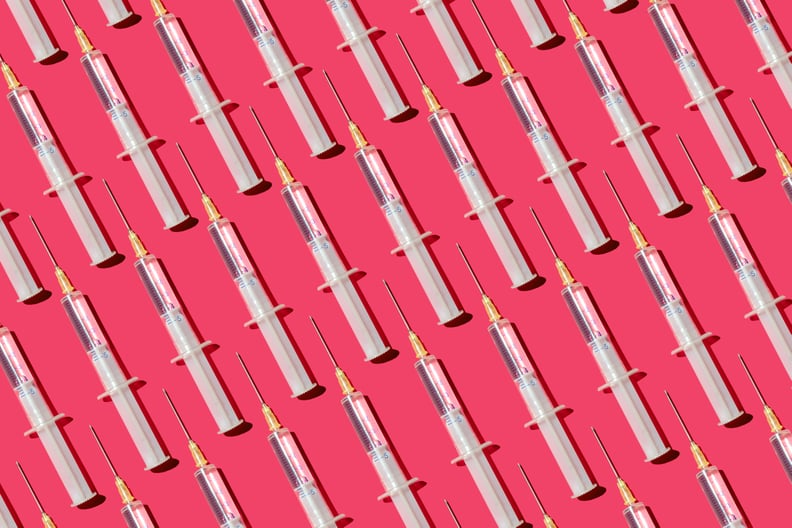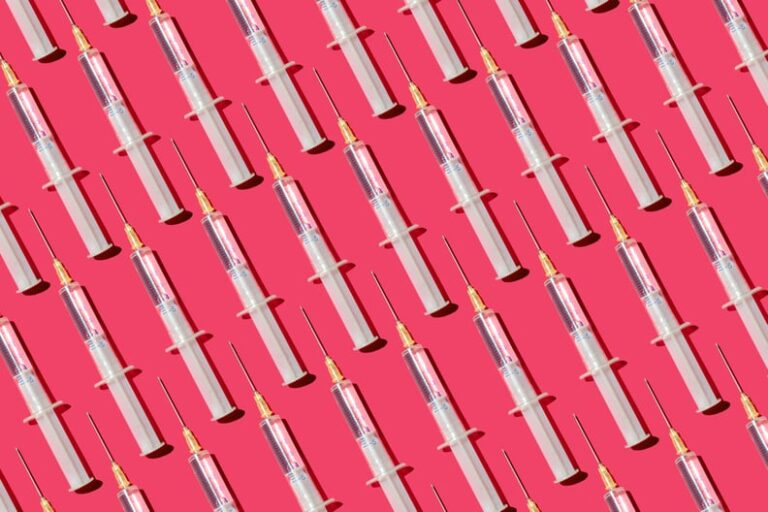
 Getty | Yulia ReznikovGetty | Yulia Reznikov
Getty | Yulia ReznikovGetty | Yulia Reznikov
While we’re fully aware aging skin and facial features are a part of life (and totally OK), we’re also firm believers in knowing about all the options available to you. Good nutrition, great skin-care products, and an overall healthy lifestyle, of course, make a difference, but for the bigger adjustments, there are more permanent and semi-permanent options like plastic surgery and injectables. A new treatment to pop up in the former category is temple filler.
Whether you’re looking to finally get rid of the little lines between your eyebrows or you want to add a bit of volume to your smile, injectables can help. Dermal fillers and neurotoxins like Botox are often used in areas that aren’t FDA approved, and while some areas are less common — think “trap” tox and “calf” tox — others have been popular for years. Temple filler is one of the easiest ways to get rid of the “peanut head” look, and it can give you a more youthful appearance.
Recently, Juvederm Voluma XC was approved by the FDA for injection into the temple region, which has us wondering whether it is time to book a temple filler appointment with our injector. According to experts, it’s a tiny “tweakment,” but it can often make a big difference if you need it.
Ahead, we chatted with Deirdre Hooper, MD, a board-certified dermatologist at Audubon Dermatology in New Orleans, to learn all about temple fillers, such as who is a good candidate and what they typically cost. Keep scrolling to learn more.
What Is Temple Filler?
To first understand what temple filler is, you need to know what dermal fillers are. For the unfamiliar, dermal fillers are injectable substances that are used to reduce the appearance of fine lines, wrinkles, and sagging skin. They are also used to add volume back to the face where it has been lost. Temple filler is used to create a balanced facial shape and to contribute to a youthful appearance.
“It adds volume to lift and add shape, contour, and structure to your temple,” Dr. Hooper tells PS. “This creates a more natural and youthful appearance, which is a smooth transition from the cheekbone to the forehead, rather than a dip and hollow.”
The process is relatively simple and typically not painful. “As with all injection procedures, the needle can cause a little bit of discomfort during the procedure, and the product actually being in your temple can cause mild discomfort after the procedure for a short amount of time,” Dr. Hooper says. “The product does contain lidocaine, so while you’re being injected, you’re also being numbed as you undergo the treatment; it’s really almost painless.” Additionally, your provider may even choose to use topical anesthesia or an injected numbing agent, which can further minimize any discomfort.
Immediately after receiving temple filler, Dr. Hooper says she advises her patients to refrain from exercise, makeup, and alcoholic beverages for 24 hours. She also notes that patients should avoid supplements that may increase bruising, like ibuprofen, fish oil, and vitamin E, both before and after.
Who Is a Good Candidate For Temple Filler?
Anyone experiencing moderate to severe temple hollowing is a good candidate for temple filler. Dr. Hooper notes an easy way to test is to check for what is typically called “bony show.” “If you can see the bony contours/ridges around your eye or at the edge of your forehead, or a shadow on the side of your eye or in your temple, that indicates you may have moderate to severe volume loss, and that you’re likely a candidate for temple filler,” she says.
Temple Filler Side Effects
One of the main risks with any dermal filler is the unintentional injection into a blood vessel, so Dr. Hooper says it’s crucial to visit a provider who has been properly trained to use the appropriate technique. “If you inject gel into a blood vessel, the complications can be serious and may be permanent,” she adds. “Those complications can include vision abnormalities, blindness, stroke, temporary scabs, or permanent scarring of the skin.” Additionally, as with all skin injection procedures, there is also a risk of infection. “In clinical studies, the most common reported side effects were tenderness, swelling, firmness, lumps/bumps, bruising, redness, pain, discoloration, and itching,” Dr. Hooper says.
Temple Filler Cost
The cost of temple filler will depend on the provider you decide to visit as well as your location and how much filler is used. “In my practice, this depends on the volume of products that I need and is typically in the range of $800 to $1,000 per syringe of product,” Dr. Hooper says. “However, full correction may require multiple sessions of one to two syringes per treatment, usually not more than four syringes in total for that long-lasting outcome.”
Additionally, in trials using Juvederm Voluma XC, results from the treatment lasted up to 13 months.
Temple Filler Before and After
Renee Rodriguez is a staff writer and social producer for POPSUGAR. She writes across all verticals, but her main areas of expertise focus on fashion and beauty content with an emphasis on reviews and editor experiments. She also produces social content for POPSUGAR’s TikTok and Instagram accounts.

